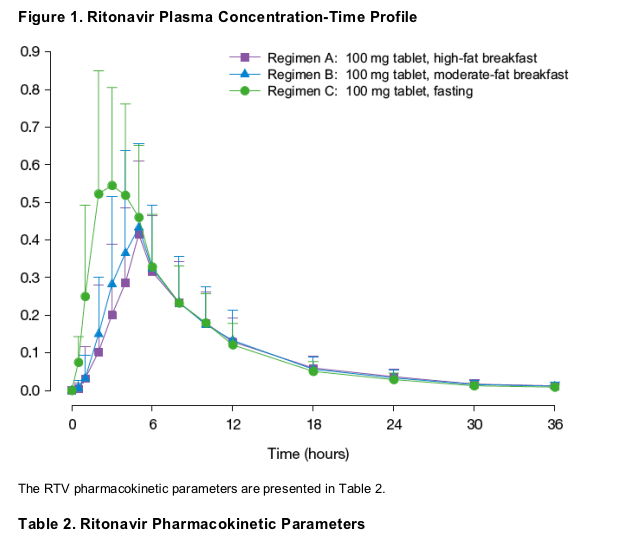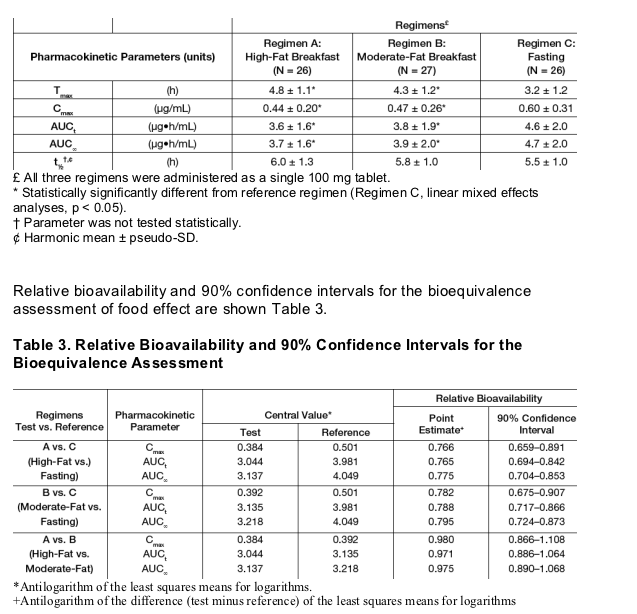 |
 |
 |
| |
The Effect of Food on Ritonavir Bioavailability Following Administration of Ritonavir 100 mg Film-Coated Tablet in Healthy Adult Subjects
|
| |
| |
Reported by Jules Levin
CE Klein, YL Chiu, W Awni, J Ng, Y Cui, J Morris, T Podsadecki, D Kim, B Bernstein
Abbott Laboratories, Abbott Park, IL, USA ♦ HIV 9 ♦ 9-13 November 2008 ♦ Glasgow, UK
AUTHOR CONCLUSIONS
Food had a slight effect on the bioavailability of the RTV tablet. The central values of Cmax and AUC∞ from the RTV tablet administered following
a high-fat breakfast and a moderate-fat breakfast were 20 to 23% lower, on average, than that observed when the RTV tablet was administered under fasting conditions.
Fat content did not affect the bioavailability of RTV from the tablet formulation. The 90% confidence intervals for log-transformed AUC and Cmax
were contained within the 0.80 to 1.25 range for the RTV tablet administered following a high-fat breakfast compared to administration of the tablet following a moderate-fat breakfast.
Administration of the RTV tablet under fed conditions is expected to result in RTV exposures closer to the SGC than when the RTV tablet is administered under fasting conditions. Therefore, consistent with the recommendation for the marketed SGC and oral solution, the to-be-marketed tablet should be administered with food.
Overall, the RTV tablet formulation was generally safe and well tolerated. No differences were seen among regimens for their adverse event profiles. There were no apparent differences among the regimens with respect to safety.
ABSTRACT
A new 100 mg tablet formulation of ritonavir has been developed that would not require refrigeration. This study compared the single-dose bioavailability of the final ritonavir 100 mg tablet formulation following a moderate-fat or high-fat meal relative to that of under fasting conditions.
This was a single-dose, open-label, 3-period crossover study with a randomized crossover design. Healthy male and female subjects (N=27) participated in the study. Serial blood samples were collected for 36 hours after each dose. Ritonavir AUC from time 0 to the last measurable concentration (AUCt) and from time 0 to infinity (AUC∞), maximum plasma concentration (Cmax) and time of Cmax (Tmax) were determined using noncompartmental methods. The bioavailability of the tablet following a meal relative to the fasting condition was assessed by the two one-sided tests procedure using 90% confidence intervals (CI). Safety was assessed throughout the study.
Ritonavir Cmax and AUC were approximately 20-23% lower when dosed following a meal compared to administration under fasting conditions.
Ritonavir pharmacokinetics after administration of the tablet are slightly affected by meal content (with moderate or high fat). The slight difference in Tmax is consistent with delayed gastric emptying following a meal. Overall, the tablet formulation was generally safe and well tolerated. Administration of the RTV tablet is expected to result in RTV exposures closer to the SGC under fed conditions than the RTV tablet administered under fasting conditions. Therefore, consistent with the recommendation for the marketed SGC and oral solution, the to-be marketed tablet should be administered with food.
INTRODUCTION
Norvir Tablet Program objectives:
-- Develop a heat-stable ritonavir (RTV) tablet formulation while maintaining a boosting effect similar to that of the current RTV soft gel capsule (SGC).
-- Ensure adequate stability to allow for worldwide use, including in the developing world.
Data were previously presented comparing the bioavailability of ritonavir (RTV) following administration of the tablet to the SGC at a dose of 100 mg under moderate fat conditions.1
-- The RTV AUC was bioequivalent to that of the marketed SGC.
-- The RTV Cmax was approximately 26% higher after RTV tablet administration compared to the marketed SGC.
-- No differences were seen between RTV tablet and RTV SGC in terms of adverse event profile and overall safety.1
This food effect study was designed to evaluate the bioavailability of a single 100 mg dose of a test RTV tablet under moderate-fat or high-fat meal conditions.
Study Methods & Designs
Healthy HIV-negative adults (N=27) were enrolled into this single-dose, open-label, three_period, randomized crossover design study.
Subjects were randomized to receive one of three sequences in the morning on Study Day 1 of each period as follows:

-- Regimen A: A single RTV 100 mg tablet administered following a high-fat breakfast (907 Kcal; 52% calories from fat).
-- Regimen B: A single RTV 100 mg tablet administered following a moderate-fat breakfast (857 Kcal; 31% calories from fat).
-- Regimen C: A single RTV 100 mg tablet administered following a 10-hour fast.
Twenty-seven (27) subjects were included in the PK analyses (Table 1).
-- One subject was discontinued prior to dosing in Period 3 due to a positive urine amphetamine screen. One subject discontinued prior to dosing in Period 3 due to an adverse event (mild hematuria).

Pharmacokinetic Analysis
♦ Blood samples were collected for RTV assay at pre-dose (0 hour) and at 0.5, 1, 2, 3, 4, 5, 6, 8, 10, 12, 18, 24, 30 and 36 hours after dosing on Study Day 1 in each period.
♦ Drug concentrations for RTV were measured by validated LC/MS/MS method with a lower limit of quantitation (LLOQ) of 1.00 ng/mL.
♦ RTV PK parameters were calculated with standard non-compartmental analysis using WinNonlin v. 5.2 software (Pharsight Corp., Mountain View, CA) to estimate the maximum observed concentration (Cmax), time to the maximum observed concentration (Tmax), terminal phase elimination half_life (t1/2), area under the plasma concentration time curve from time 0 to the last measurable concentration (AUCt) and AUC from time 0 to infinite time (AUC∞).
Statistical Analysis
A linear mixed effects analysis was performed for Tmax, Cmax, AUCt and AUC∞. Two one-sided tests were used to compare the RTV 100 mg tablet
administered under high-fat and moderate-fat meal conditions to the RTV 100 mg tablet administered under fasting conditions and to compare the tablet administered under high-fat to moderate-fat meal conditions.
Safety Analysis
Safety and tolerability were assessed throughout the study based on reported adverse events (AEs), vital signs and clinical laboratory measurements.
RESULTS
The observed plasma concentration versus time profiles for the RTV tablet are shown in Figure 1.


After administration of the RTV tablet formulation under various meal conditions, the RTV Cmax and AUC values were approximately 20-23% lower when dosed following a high-fat or moderate-fat meal compared to administration under fasting conditions.The slight delay in Tmax is consistent with delayed gastric emptying following a meal.
When the RTV tablet was administered with food, RTV exposure was not affected by meal content (i.e., high-fat vs. moderate-fat meal), since the 90% confidence intervals for log-transformed AUC and Cmax were contained within the 0.80 to 1.25 range for the RTV tablet administered following a high-fat breakfast versus a moderate-fat breakfast.
Adverse Events
The regimens were generally safe and well tolerated. No differences were seen among regimens for their adverse event profiles. The majority of AEs (6/7, 86%) were mild in severity.
REFERENCE
1. Klein CE, Chiu YL, Awni W, Ng J, Xiong J, Roth W, Podsadecki T, Kim D, Bernstein B. A Pivotal Biostudy Comparing Ritonavir 100 mg Film-Coated Tablet to a Ritonavir 100 mg Soft Gelatin Capsule in Healthy Adult Subjects. IAS 2008, Mexico City, Podium Presentation (THAB04).
|
| |
|
 |
 |
|
|